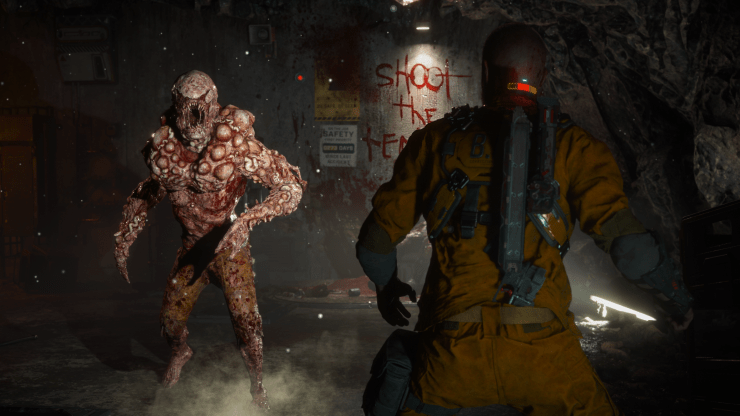The Callisto Protocol wears its inspirations and ancestry on its sleeve: it’s a dark, violent survival horror game directed by Glen Schofield, the co-creator of the original Dead Space.
Like Dead Space, if you had to use one word to describe Callisto, that word would be, as Schofield himself has said, “brutal.” Enemies fasten onto your neck, spring out of nowhere, shrug off gunfire, and are actively trying to mutate into something even worse.
If you don’t splatter them across the wall, they might not actually be dead, so your first move whenever something stops moving is to run over there and stomp in its rib cage. It’s like the fight choreographer for Brawl in Cell Block 99 made a horror game.
If this all sounds familiar, it should. The Callisto Protocol is effectively the Bloodstained to Dead Space‘s Castlevania: Symphony of the Night. It’s not necessarily a one-to-one match to its spiritual predecessor, and does do a couple of new things, but nobody involved is denying the obvious connection.
I attended a virtual press event for Callisto on Monday which showed some new gameplay from roughly the halfway point of the game. While the developers did provide a brief tutorial to explain Callisto‘s mechanics, the gameplay was presented edited but without commentary, showing Callisto‘s protagonist Jacob Lee as he made his way through a level called Habitat.
It’s the 24th century, and Jacob is a pilot who’s been imprisoned in Black Iron, a facility on Jupiter’s moon Callisto. When an outbreak of a strange disease mutates many of the humans in the colony into hostile “biophages,” Jacob is left to find a way out on his own.
One of the facets of Dead Space that I thought would catch on harder than it did was its diagetic approach to its user interface, but much of that approach is back in The Callisto Protocol. The player can track Jacob’s health via a meter that’s installed on the back of his neck, and his weapons feature a holographic display that shows their current ammo count. There isn’t any element of the UI that Jacob himself can’t see.
Callisto also shares a lot of Dead Space‘s particular vision of the future, although it’s a little more justified here. Black Iron is a hellhole built into the surface of a dead moon that’s currently under direct attack from a hostile mutation, and Jacob’s climbing around its maintenance level. Naturally, that means it’s all hissing pipes and malfunctioning equipment, punctuated by the occasional biophage hive. This isn’t the Ishimura, which never looked like someplace that people would voluntarily want to live; Black Iron was bad on purpose, and now it’s gotten worse.
The biggest change in Callisto is its emphasis on melee combat, which was always something you only did in Dead Space if you were out of any other options. Jacob has a six-shot “hand cannon,” but it only seems to annoy the typical biophage.
Instead, you get most of your moment-to-moment work done in Callisto with a heavy stun baton. You can dodge or block incoming attacks, then land a quick counterhit to beat a biophage to the floor. Your gun’s got its uses, like kneecapping an oncoming enemy, but the baton’s the star of the show.
One of the primary methods of dealing with single enemies is what Striking Distance calls a skill shot, where you use your baton to stagger a biophage and set it up for a targeted, point-blank gunshot. This deals significantly more damage than a bullet does by itself, and can be used to destroy specific parts of an enemy before they have the chance to mutate any further.
That’s a significant risk, as Callisto‘s biophages aren’t quite done baking yet. A lot of the enemies in the demo could spontaneously mutate into other, more dangerous forms unless you interrupted the process with violence. One inflated into a giant mass like a tumor with legs; another seemed perfectly content to keep coming after you despite the loss of most of its head.
That was actually the moment from the demo that’s stuck with me the hardest. For a second, as a decapitated biophage attacked Jacob with a slew of tentacles from its neck stump, you could see what was left of its bottom row of human teeth. It was a near-perfect moment of sheer body horror.
Jacob also comes equipped with a gravity weapon on his hand called a GRP, which can be used for short-ranged telekinesis. It’s useful as a quick way to get some space, to throw enemies across the room or into one another, or to bean a biophage with random debris or explosive canisters. You can also use the GRP to toss mutants into local hazards, like gears, grinders, or wall spikes.
I didn’t actually go hands-on with The Callisto Protocol; this was all pre-recorded. I can’t testify to how it feels to play it. Schofield was careful to say that the game is deliberately meant to be challenging, however, and the demo featured a lot of Jacob getting his head handed to him. I’m expecting the final version of The Callisto Protocol will be deliberately difficult.
The Callisto Protocol is due out for PlayStation 4/5, Xbox One, Xbox Series X|S, and PC on December 2.
The post ‘The Callisto Protocol’ Preview – We Experience the Game’s Body Horror Brutality Ahead of Launch appeared first on Bloody Disgusting!.



